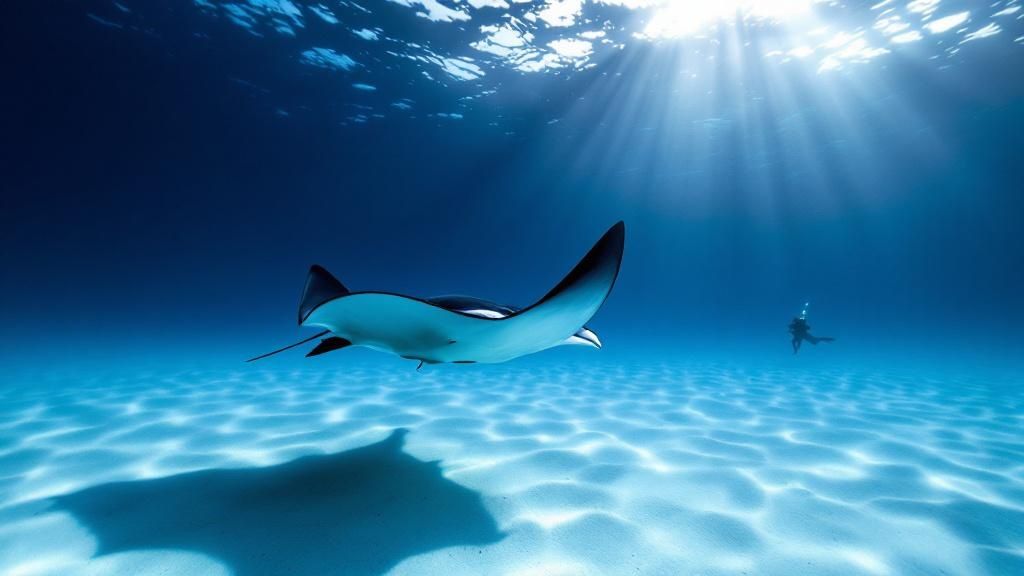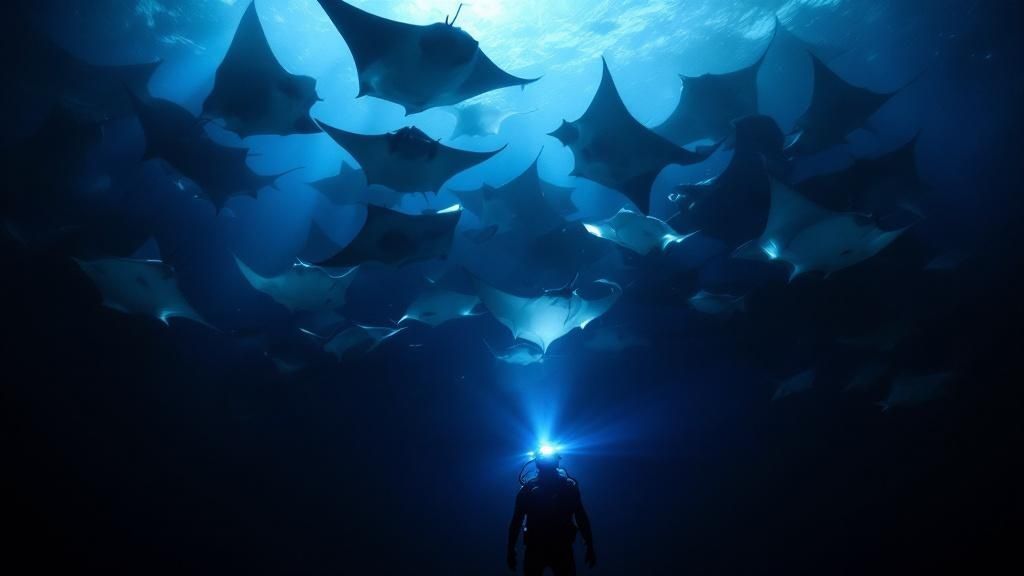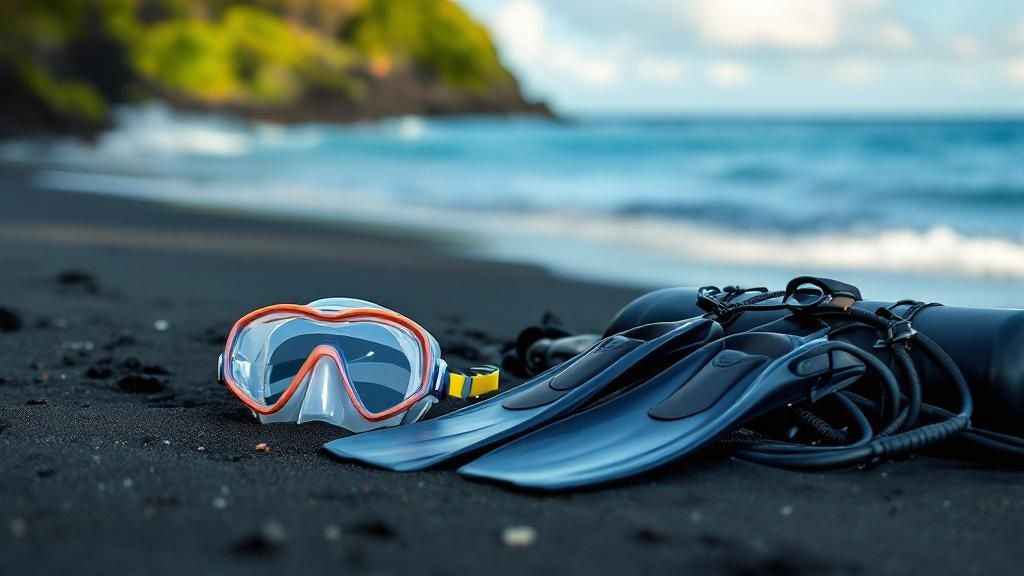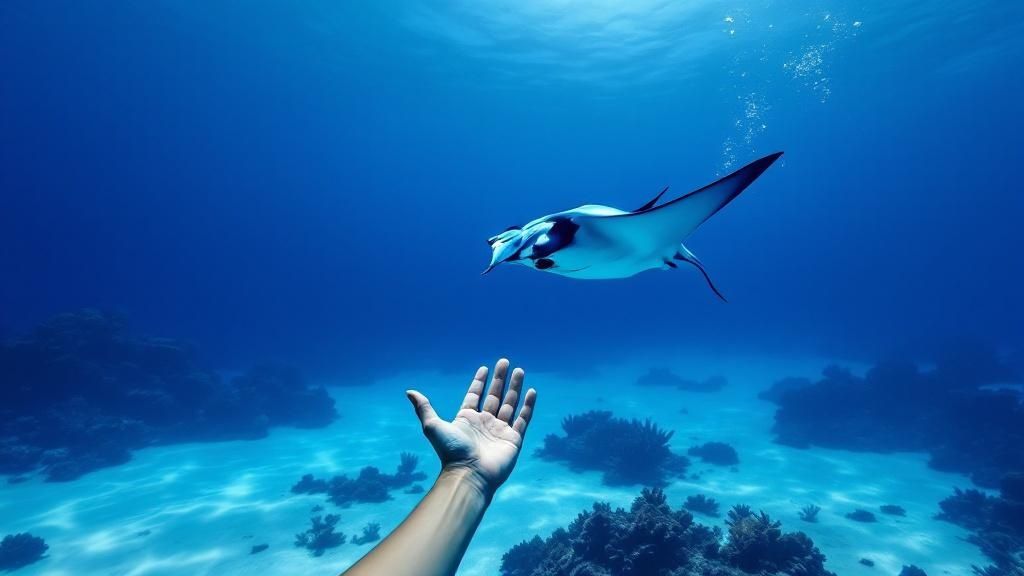Picture this: you're floating in the warm, inky blackness of the Pacific Ocean. Suddenly, a giant, otherworldly creature with an incredible wingspan glides past you, silent and graceful. This isn't a scene from a movie; it's the manta ray dive kona experience, an encounter so magical it's often called an "underwater ballet." It’s truly one of the world's top wildlife encounters for a reason.
Why the Kona Manta Ray Dive Is a Global Phenomenon

So, what makes the Big Island's Kona coast the world's most famous stage for manta rays? It's a fascinating mix of biology, geography, and a bit of human ingenuity that creates a reliable and absolutely breathtaking spectacle almost every single night.
The whole thing works on a beautifully simple principle. After the sun goes down, tour boats head to specific sites and shine powerful lights down into the water. These lights act like a massive bug zapper, but for the ocean, attracting huge clouds of plankton—the microscopic critters that manta rays love to eat. For the local reef mantas, this is basically an all-you-can-eat buffet delivered right to their doorstep.
The Science of the Spectacle
This nightly feeding frenzy is what truly sets the Kona experience apart. In many other places, you might get a fleeting glimpse of a manta at a "cleaning station," where smaller fish pick parasites off them. But here, you get a front-row seat to the main event: dinner time.
You'll watch in awe as these gentle giants perform mesmerizing barrel rolls and somersaults, their huge mouths wide open to scoop up the plankton-rich water. We're not talking about a quick fly-by. This is a sustained performance where mantas, some with wingspans stretching over 12 feet, glide just inches away from you.
The Kona Coast is legendary for its manta ray night dives, especially at sites like Manta Village and Manta Heaven. What makes it so reliable? The sheer numbers. Divers here see an average of 20 mantas per night—that's double what you’d find at other top spots around the globe. This incredible consistency is why Kona is a bucket-list destination for divers.
More Than Just a Dive
This guide is your complete playbook for this unforgettable adventure. We’ll cover everything from picking the best tour to understanding your role in protecting these amazing animals. The manta ray night dive in Kailua-Kona is more than just a tour; it's an experience that leaves you with a profound sense of wonder for the ocean.
This isn't just about observing marine life from a distance; it’s about being welcomed into their world for a few magical hours. To really get a feel for the epic Hawaiian adventure of Manta Ray diving in Kona, you'll find some great stories and insights there. From the moment you slip into the twilight sea to the final, ghostly glide of the last manta into the darkness, you'll know exactly why this is an experience you can't miss.
Choosing Your Kona Manta Ray Adventure

So, you're ready to experience the magic of Kona's manta rays. Fantastic! The next step is figuring out which adventure is the right fit for you. This isn't a one-size-fits-all experience. The best tour really comes down to your comfort in the water, your skill level, and what kind of encounter you're dreaming of.
Think of it like choosing a hiking trail. Some are gentle, scenic walks perfect for just about everyone, while others are more challenging climbs meant for seasoned adventurers. The two main "campsites" for this nightly spectacle—Manta Village and Manta Heaven—are just like that. They're two distinct environments, and understanding the differences is key to booking the perfect trip.
Diving vs. Snorkeling: What's The Difference?
The first big decision you'll make is how you want to see the mantas: from the surface as a snorkeler or from the ocean floor as a scuba diver. This choice completely changes your perspective and how you experience the whole thing.
-
Snorkeling: If you go the snorkeling route, you'll float on the surface, usually holding onto a big, custom-made light board. This board shines powerful beams down into the dark water, which is what attracts the plankton. The mantas then swoop up from the depths to feed, gliding just inches below you in a breathtaking, silent ballet. It’s an incredibly accessible and safe option, making it a great choice for families and anyone who isn't scuba certified.
-
Scuba Diving: Certified divers get an entirely different viewpoint. You’ll descend to the sandy bottom, around 35-40 feet deep, and settle in with your group. From there, you're looking up. The snorkelers' lights create a glowing "stage" above you, and you get to watch the mantas perform their acrobatic barrel rolls against that illuminated backdrop. It’s a truly immersive, 360-degree show.
"Choosing between snorkeling and diving is all about perspective. Snorkelers get the top-down, 'aerial' view as mantas glide just beneath them. Divers get the bottom-up, 'IMAX theater' experience, witnessing the full scale of the underwater ballet from below."
This choice is crucial because the two primary sites, Manta Village and Manta Heaven, are each better suited for one activity over the other.
Manta Ray Dive vs Snorkel Experience in Kona
To help you decide, here’s a quick comparison of the key differences between the diving and snorkeling options for the manta ray encounter. This should help you pick the best fit for your trip.
| Feature | Diving Experience | Snorkeling Experience |
|---|---|---|
| Perspective | Bottom-up view from the ocean floor | Top-down view from the water's surface |
| Proximity | Mantas may glide directly overhead | Mantas feed just feet below your light board |
| Certification | Scuba certification required | No certification needed; basic swimming comfort |
| Equipment | Full scuba gear (tank, BCD, regulator) | Mask, snorkel, fins, and a floatation light board |
| Best Site Match | Manta Heaven (deeper) or Manta Village | Manta Village (calmer, shallower) |
Both experiences are incredible, offering a unique connection with these gentle giants. It's less about which is "better" and more about which perspective you'd prefer to have.
Comparing The Two Premier Manta Sites
Just as important as how you see the mantas is where you see them. Kona’s operators primarily use two sites, and each has its own distinct personality.
Manta Village (Keauhou Bay)
This is the original, world-famous site located just a short boat ride from Keauhou Bay, right offshore from the Sheraton Kona Resort.
- Best For: Snorkelers and beginner divers.
- The Vibe: It's a shallower site, which often makes it feel less intimidating for new divers. The bay is also more protected, so it's generally calmer and leads to very few cancellations from rough weather. It can get busy, but the manta sightings are incredibly consistent. We're talking a very, very high success rate.
Manta Heaven (Garden Eel Cove)
You'll find this site a bit further north, near the Kona airport. It offers a slightly different, but equally amazing, adventure.
- Best For: Confident snorkelers and certified scuba divers.
- The Vibe: The site is a bit deeper, which is why many experienced divers love it—it provides a more dramatic vertical view as the mantas ascend. Because it’s more exposed to the open ocean, trips here are occasionally canceled due to swells. When the conditions are good, though, you can sometimes see even larger groups of mantas.
Ultimately, there is no wrong choice, only the one that is right for you. If you're wondering why you should go on a manta ray dive in Kona, it's because both options deliver a truly awe-inspiring connection with nature. Just think about your group's comfort level and what kind of memory you want to create.
How to Prepare for Your Night Dive
Getting ready for your manta dive is the secret ingredient that takes the experience from "good" to "unforgettable." A little bit of smart planning beforehand means that when you’re on the boat, you can relax and focus completely on the incredible spectacle about to unfold.
Think of it this way: you wouldn't go hiking without the right shoes, and you wouldn't head to the beach without a towel. Preparing for this dive is no different. It’s all about setting yourself up for a smooth, comfortable, and stress-free adventure.
First Things First: Choose a Responsible Operator
Before you even think about packing a bag, your most critical decision is picking the right tour company. This is a big one. You're not just looking for a boat ride; you're looking for a team that genuinely cares about your safety and the well-being of the manta rays.
A great operator will be committed to sustainable practices. You might hear about the old "Manta Ray Green List," and while that official program ended in 2023, its core principles are still the gold standard. The best companies live and breathe these guidelines for responsible manta interactions.
When you're researching, don't be shy about asking some direct questions before you book:
- What's the typical group size for your manta ray dive kona tour? Smaller groups almost always lead to a better, more personal time in the water.
- Can you tell me about your safety procedures and guide-to-guest ratio?
- Do you offer a "manta guarantee"? Most top-tier operators will happily give you a free return trip if the mantas decide not to show up.
A few minutes of vetting an operator pays off huge dividends. It ensures you’re supporting ethical tourism and signing up for a truly world-class experience.
Your Night Dive Packing Checklist
With your trip booked, it's time to get your gear together for the evening. The good news is that your tour company will provide all the main equipment—wetsuit, mask, snorkel, or full dive gear. Your job is to pack for your own comfort.
What to Bring With You:
- A Towel & Dry Clothes: This is an absolute must. After spending up to an hour in the ocean after sunset, you’ll be so glad you have a warm, dry set of clothes for the ride back to shore. A cozy sweatshirt or windbreaker is perfect.
- Motion Sickness Remedies: If you have even the slightest tendency toward seasickness, take something before you leave the dock. Trust me, feeling queasy can completely derail the magic of the night.
- Reusable Water Bottle: It’s always smart to have water on hand, and bringing your own helps cut down on single-use plastic.
- Waterproof Bag: A simple dry bag is a lifesaver for protecting your phone, keys, and wallet from the inevitable boat spray.
I can't stress this enough: that boat ride back to the harbor can feel surprisingly cold after you get out of the water. Having a warm sweatshirt waiting for you will feel like pure luxury. Don't skip it!
So what can you leave at the hotel? Ditch any valuables you don't absolutely need, oversized bags, and anything that can't handle getting a little wet. Keep it simple.
Getting in the Right Headspace
For a lot of people, especially if it's your first night dive, the moments before you get in the water are a mix of pure excitement and a few butterflies. Slipping into the dark ocean is a unique sensation, but it’s important to remember this is an incredibly safe and highly controlled activity.
If you feel any pre-dive jitters creeping in, just focus on your breath. Take some slow, deep breaths on the boat ride out. Pay close attention to your guide's safety briefing—their calm confidence is contagious. You'll be with a whole group of people and a professional crew whose only job is to ensure you have a safe and amazing time.
So, relax. Trust the pros, embrace the darkness, and get ready for a show you'll never forget.
What to Expect When You Meet the Mantas

As your boat pulls away from the harbor, the real magic begins. You'll cruise along the Kona coast while the sky puts on a show, shifting from brilliant orange to deep purple. This isn't just a boat ride; it’s the calm before the spectacular main event. The warm Hawaiian air and the gentle rock of the boat are the perfect overture.
The trip out to the site is your chance to get the inside scoop from the expert guides. They’ll share fascinating stories about the local reef mantas you’re about to meet. You’ll learn how each one has a unique spot pattern on its belly—a natural fingerprint that allows researchers to identify and even name them.
This pre-dive briefing is also where you’ll get a solid safety rundown. The crew explains exactly how the encounter will play out, making sure everyone feels confident. They’ll go over the simple "rules of engagement," which are all about observing passively to keep both you and these gentle giants safe.
Entering the Underwater Theater
Then, the moment you’ve been waiting for arrives. With the sky now a blanket of inky black, you’ll slip into the surprisingly warm Pacific. The world above simply melts away, replaced by the muffled sounds of the ocean and the steady rhythm of your own breathing.
Divers head down to the sandy bottom, usually about 35 feet deep, and find a spot around a central light structure. It’s affectionately known as the "campfire." Your group will form a semi-circle, aiming your dive lights up to create columns of light that cut through the darkness, drawing in the plankton.
Up on the surface, snorkelers will hold onto a specially made light board. This board shoots powerful beams down into the water, creating a glowing stage directly below. Whether you're on the bottom or the top, you've just become a key part of the show—you're setting the dinner table.
The Grand Arrival
As you wait in the dark, bathed in the soft glow, your senses sharpen. You can feel the vastness of the ocean all around you. And then it happens. A ghostly shape glides in from the edge of the light. The first manta ray has arrived.
The first glimpse is breathtaking. They are bigger, more majestic, and more graceful than any video can convey. They move with an impossible elegance, their giant wings propelling them with slow, powerful flaps. Any nerves you had instantly evaporate, replaced by pure awe.
People often call it an "underwater ballet," and for good reason. As more mantas join, they begin a mesmerizing dance, performing effortless barrel rolls and somersaults to scoop up the plankton gathered in the light. They'll soar just inches from your face, their huge mouths wide open, completely unbothered by your presence.
A Full Sensory Experience
The manta ray dive kona is something you feel with all your senses. You'll feel the gentle push of the current, see the unbelievable spectacle of the feeding ballet, and hear the quiet hum of the ocean around you. It’s a powerful connection to the natural world. If you find yourself captivated by these kinds of encounters, you might also be interested in other marine adventures, like the thrilling shark experiences available in other parts of the world.
The dive itself usually lasts around 45 minutes, but time seems to stand still. Your guides are in the water with you the whole time, making sure everything runs smoothly and often pointing out famous resident mantas by name. Watching them is a beautiful reminder that you are a visitor in their home. The memory of a manta ray’s eye meeting yours as it glides past is something that sticks with you forever—a silent, powerful moment that defines the magic of Kona.
Practicing Safe and Responsible Manta Tourism
Having an incredible, up-close encounter with Kona's manta rays means we have to respect and protect them. It's the only way to ensure these gentle giants will be here for future generations to see. The whole experience boils down to one simple idea: you are a guest in their home. When you really take that to heart, your manta ray dive kona adventure becomes more than just a tour—it’s a genuine act of conservation.
The cornerstone of this entire philosophy is passive observation. It’s a straightforward but powerful concept. We look, we admire, and we let the mantas call all the shots. We're there to witness their natural ballet, not to change the choreography.
This approach is built on a few rules that are absolutely non-negotiable. The big one is to never, ever touch a manta ray. Imagine their skin is coated with a delicate, invisible shield. This thin mucus layer is their primary defense against nasty bacteria and infections swimming around in the ocean.
Touching a manta, even with the lightest finger, can wipe off that protective slime coat. It’s like leaving them with an open wound, making them vulnerable to disease. The best way to show these animals love is to keep your hands to yourself.
The Golden Rules of Manta Interaction
To make sure every dive is safe for both people and mantas, the best operators enforce a clear set of guidelines. Following them isn’t just good manners; it's how you personally contribute to the long-term health of Kona’s beloved manta population.
- Stay in Your Zone: If you're diving, you'll stay on or very near the sandy bottom. If you're snorkeling, you'll stay on the surface. This creates an open "manta highway" in the middle of the water column, giving them a clear, safe path to swoop in and feed.
- No Chasing or Blocking: It's tempting, but you have to resist the urge to swim after a manta or get in its way. Chasing stresses them out, and blocking their path messes up their feeding. Be patient and let them come to you.
- Lights On, But Aim Smart: Your dive light is what attracts their food, the plankton. But you never want to shine it directly into a manta's eyes. Divers should point their lights straight up, and snorkelers should point theirs straight down. This creates a beautifully lit "plankton buffet" for the mantas to enjoy.
Choosing a tour company that lives and breathes these standards is the single most important decision you'll make. The old "Manta Ray Green List" program may not be active anymore, but its spirit of sustainability is alive and well. The top-tier operators continue to follow these strict, conservation-first guidelines, always putting the mantas' well-being first.
A Community Effort Backed by Law
The commitment to protecting these amazing creatures goes way beyond the dive boats. Hawai'i recognized the threats mantas face worldwide and took a groundbreaking step. Back in 2009, the state passed a law making it illegal to knowingly capture or kill manta rays in Hawaiian waters. This was a critical move to protect our local populations and highlights just how important they are to our ecosystem and economy. You can explore more about these foundational conservation efforts and why they matter so much for the future of Kona's mantas.
Your part in all this is simple but absolutely essential. By picking a responsible operator and following the rules in the water, you become a partner in this incredible conservation success story. You can learn more about what to expect and how to prepare by checking out our complete guide on what you should know about the manta ray dive in Kona. Being a respectful guest ensures that the magic you get to witness will still be here for many, many years to come.
Answering Your Questions About the Kona Manta Dive

Even after doing your homework, it’s completely normal to have a few last-minute questions before an adventure like this. I've been doing this for years, and I still get butterflies. Let's walk through some of the most common things people ask, so you can head out on the water feeling totally prepared and excited.
We'll cover the big ones—safety, timing, and what to expect—to clear up any lingering doubts.
Is the Manta Ray Dive Safe for Beginners?
You bet it is. Local operators are pros at making everyone, from seasoned divers to first-time snorkelers, feel comfortable and safe. If you're not a certified diver, don't worry! The snorkeling option is just as incredible and wildly popular.
As a snorkeler, you'll hold onto a specially designed light board and float on the surface. The real magic happens right below, as the mantas swoop and feed just feet from you. For anyone curious about scuba, most outfits offer an intro "discovery dive," where a certified instructor is literally by your side the entire time. The Manta Village site is especially great for newcomers, as it's shallower and generally has calmer waters.
What Is the Best Time of Year to See Manta Rays in Kona?
This is the best part: there is no bad time. The Kona manta ray dive is a world-class experience that runs year-round. Our local reef mantas are residents, not tourists, meaning they stick around the Kona coast all year long. You have a great shot at seeing them no matter when you book your trip.
While the ocean can be a bit flatter in the summer, operators consistently report a success rate of over 90% for seeing mantas throughout the entire year. That kind of reliability is almost unheard of in wildlife tours.
My biggest piece of advice? Book your manta tour for one of the first nights of your vacation. That way, if a rare cancellation happens due to weather, you have plenty of time to reschedule and don't risk missing out.
Are We Guaranteed to See Manta Rays?
Since these are wild animals, no one can offer a 100% guarantee. But let me tell you, the Kona manta dive comes as close as you can get. The local ecosystem is so dependable that the odds are overwhelmingly in your favor—it's one of the most reliable marine life encounters on the planet.
To back this up, almost every reputable company has a "manta guarantee." If your trip happens to be one of the very few where no mantas show up, you can go again on another night for free (based on availability). It’s their way of showing just how confident they are that you'll have an amazing experience.
Can I Bring My Own Camera on the Dive?
Yes, you can bring an underwater camera, but there are a few crucial rules to follow to keep the mantas safe and comfortable. The single most important one is to never use a bright external flash. Sudden, sharp bursts of light can easily disorient these gentle giants.
Your best bet is to use the ambient light from the powerful central "campfire" light or the snorkel board. If you're scuba diving, please make sure your buoyancy is rock-solid before you even think about adding a camera to the mix. A great, stress-free option is to just enjoy the moment and purchase the incredible footage from the professional videographer many boats have on board.
Ready to witness this underwater ballet for yourself? The expert crew at Kona Honu Divers is passionate about creating a safe, respectful, and truly unforgettable manta ray experience. From our custom-built boats to our seasoned guides who know these mantas by name, we make sure your adventure is second to none. Book your Manta Ray Night Dive or Snorkel with us today!
